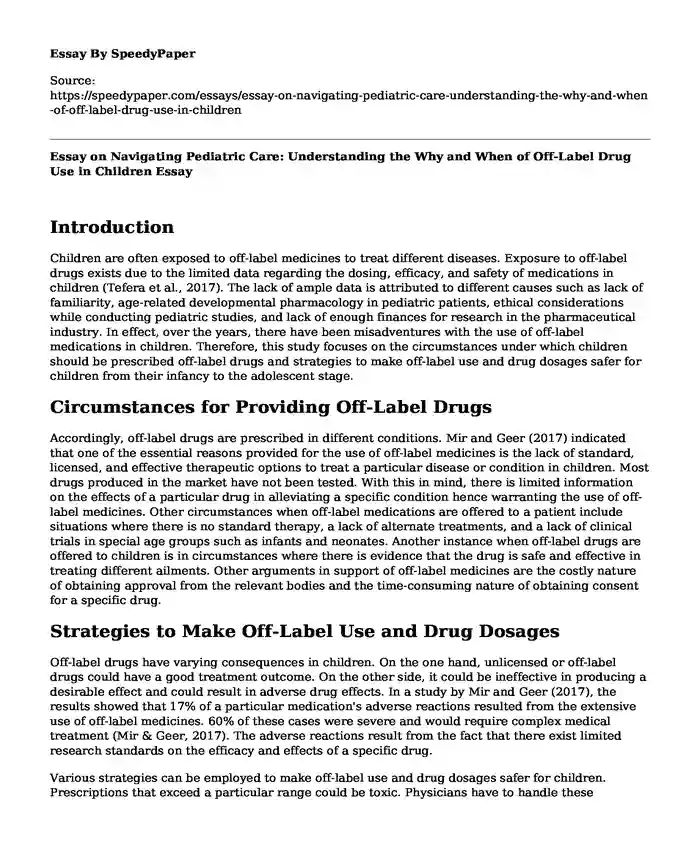
| Type of paper: | Essay |
| Categories: | Health and Social Care Child development Drug |
| Pages: | 3 |
| Wordcount: | 701 words |
Introduction
Children are often exposed to off-label medicines to treat different diseases. Exposure to off-label drugs exists due to the limited data regarding the dosing, efficacy, and safety of medications in children (Tefera et al., 2017). The lack of ample data is attributed to different causes such as lack of familiarity, age-related developmental pharmacology in pediatric patients, ethical considerations while conducting pediatric studies, and lack of enough finances for research in the pharmaceutical industry. In effect, over the years, there have been misadventures with the use of off-label medications in children. Therefore, this study focuses on the circumstances under which children should be prescribed off-label drugs and strategies to make off-label use and drug dosages safer for children from their infancy to the adolescent stage.
Circumstances for Providing Off-Label Drugs
Accordingly, off-label drugs are prescribed in different conditions. Mir and Geer (2017) indicated that one of the essential reasons provided for the use of off-label medicines is the lack of standard, licensed, and effective therapeutic options to treat a particular disease or condition in children. Most drugs produced in the market have not been tested. With this in mind, there is limited information on the effects of a particular drug in alleviating a specific condition hence warranting the use of off-label medicines. Other circumstances when off-label medications are offered to a patient include situations where there is no standard therapy, a lack of alternate treatments, and a lack of clinical trials in special age groups such as infants and neonates. Another instance when off-label drugs are offered to children is in circumstances where there is evidence that the drug is safe and effective in treating different ailments. Other arguments in support of off-label medicines are the costly nature of obtaining approval from the relevant bodies and the time-consuming nature of obtaining consent for a specific drug.
Strategies to Make Off-Label Use and Drug Dosages
Off-label drugs have varying consequences in children. On the one hand, unlicensed or off-label drugs could have a good treatment outcome. On the other side, it could be ineffective in producing a desirable effect and could result in adverse drug effects. In a study by Mir and Geer (2017), the results showed that 17% of a particular medication's adverse reactions resulted from the extensive use of off-label medicines. 60% of these cases were severe and would require complex medical treatment (Mir & Geer, 2017). The adverse reactions result from the fact that there exist limited research standards on the efficacy and effects of a specific drug.
Various strategies can be employed to make off-label use and drug dosages safer for children. Prescriptions that exceed a particular range could be toxic. Physicians have to handle these prescriptions rationally and prescribe in the correct dosages for a specified duration. Drugs that fall under the category of antimicrobials pose a significant threat due to increased resistance to the medications if used undesirably. Such medications should be prescribed based on the causative agent. Physicians should choose a drug with a narrow spectrum that is effective for treating a particular pathogen (Yewale & Dharmapalan, 2012). By applying current knowledge, medical practitioners can decide the right amount of dosages for a specific drug hence minimizing toxicity and reducing the chances of drug resistance.
Conclusion
Off-label drugs are often used to treat most of the diseases affecting children. The use of unlicensed medicines is every day due to the limited research and study on the efficacy of some drugs. In some instances, these drugs could be toxic and ineffective in treating different ailments. Enhancing safety requires applying existing knowledge and narrowing the spectrum to ensure that prescribed medication can effectively treat a particular pathogen.
References
Mir, N. A., & Geer, I. M. (2017). Off-label use of medicines in children. International Journal of Pharmaceutical Sciences and Research, 2019(2), 1820-1828. https://doi.org/10.13040/ijpsr.0975-8232
Tefera, Y. G., Gebresillassie, B. M., Mekuria, A. B., Abebe, T. B., Erku, D. A., Seid, N., & Beshir, H. B. (2017). Off-label drug use in hospitalized children: A prospective observational study at Gondar University Referral Hospital, Northwestern Ethiopia. Pharmacology Research & Perspectives, 5(2), e00304. https://doi.org/10.1002/prp2.304
Yewale, V. N., & Dharmapalan, D. (2012). Promoting appropriate use of drugs in children. International Journal of Pediatrics, 2012, 1–5. https://doi.org/10.1155/2012/906570
Cite this page
Essay on Navigating Pediatric Care: Understanding the Why and When of Off-Label Drug Use in Children. (2023, Nov 09). Retrieved from https://speedypaper.net/essays/essay-on-navigating-pediatric-care-understanding-the-why-and-when-of-off-label-drug-use-in-children
Request Removal
If you are the original author of this essay and no longer wish to have it published on the SpeedyPaper website, please click below to request its removal:
- Essay Example on the US Healthcare and Financial Issues
- Essay Sample: Improving the 7 Days Crisis Response Service Across the NHS Will Help Save Lives
- Cost-Effectiveness Models Essay Sample
- Essay Sample on Role of Chess in Education
- Essay Sample on Quality Measures in Patient Care and Reimbursement
- Compare and Contrast Essay on Waterpik vs. Standard Dental Floss
- Essay on Evolution of Food Traceability Amidst Covid-19: Regulations, Tech Shifts, and Consumer Expectations
Popular categories




